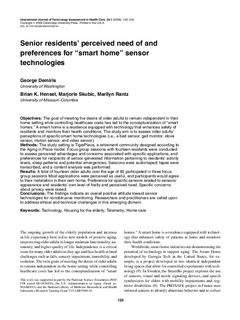| dc.contributor.author | Demiris, G. | |
| dc.contributor.author | Hensel, B.K. | |
| dc.contributor.author | Skubic, M. | |
| dc.contributor.author | Rantz, M. | |
| dc.date.accessioned | 2019-04-16T12:18:13Z | |
| dc.date.available | 2019-04-16T12:18:13Z | |
| dc.date.issued | 2008 | |
| dc.identifier.citation | Demiris, G., Hensel, B. K., Skubic, M., & Rantz, M. (2008). Senior residents' perceived need of and preferences for "smart home" sensor technologies. International Journal of Technology Assessment in Health Care, 24(1), 120-124. | nb_NO |
| dc.identifier.uri | http://hdl.handle.net/11250/2594825 | |
| dc.description.abstract | Objectives: The goal of meeting the desire of older adults to remain independent in their home setting while controlling healthcare costs has led to the conceptualization of “smart homes.” A smart home is a residence equipped with technology that enhances safety of residents and monitors their health conditions. The study aim is to assess older adults’ perceptions of specific smart home technologies (i.e., a bed sensor, gait monitor, stove sensor, motion sensor, and video sensor).
Methods: The study setting is TigerPlace, a retirement community designed according to the Aging in Place model. Focus group sessions with fourteen residents were conducted to assess perceived advantages and concerns associated with specific applications, and preferences for recipients of sensor-generated information pertaining to residents’ activity levels, sleep patterns and potential emergencies. Sessions were audio-taped; tapes were transcribed, and a content analysis was performed.
Results: A total of fourteen older adults over the age of 65 participated in three focus group sessions Most applications were perceived as useful, and participants would agree to their installation in their own home. Preference for specific sensors related to sensors’ appearance and residents’ own level of frailty and perceived need. Specific concerns about privacy were raised.
Conclusions: The findings indicate an overall positive attitude toward sensor technologies for nonobtrusive monitoring. Researchers and practitioners are called upon to address ethical and technical challenges in this emerging domain. | nb_NO |
| dc.publisher | International Journal of Technology Assessment in Health Care | nb_NO |
| dc.subject | technology | nb_NO |
| dc.subject | housing for the elderly | nb_NO |
| dc.subject | telemetry | nb_NO |
| dc.subject | home care | nb_NO |
| dc.subject | velferdsteknologi | nb_NO |
| dc.title | Senior residents' perceived need of and preferences for "smart home" sensor technologies | nb_NO |
| dc.type | Journal article | nb_NO |
| dc.source.pagenumber | 120-124 | nb_NO |
| dc.source.volume | 24 | nb_NO |
| dc.source.journal | International Journal of Technology Assessment in Health Care | nb_NO |
| dc.source.issue | 1 | nb_NO |
| dc.identifier.doi | https://doi.org/10.1017/S0266462307080154 | |
| dc.description.localcode | måsjekkes | |
